Tanzania is renowned for many beautiful cities and Towns; Kiwoito Africa is prepared to take you on a wonderful journey that will reveal the beauty of Tanzanian cities and Towns with our highly trained guides.
Welcome To Dar es Salaam, Tanzania
One of East Africa’s busiest ports, Dar es Salaam is Tanzania’s largest city and commercial center. Though “Dar,” as it’s called, is short on typical tourist attractions, it is loved among travelers for its seaside setting, surprisingly laid-back vibe, and eclectic influences, thanks to its mix of African, Arabic, and Indian cultures.
Dar es Salaam combines the clamor of Tanzania’s largest city with an agreeably relaxed pace of life. Unlike other cities in East Africa, this is not the sort of city where you see lots of other travelers. This makes it a wonderful opportunity to get a glimpse of urban African life as locals live it. Immerse yourself in its markets and street-food scenes, explore its museums and enjoy its outdoor attractions.
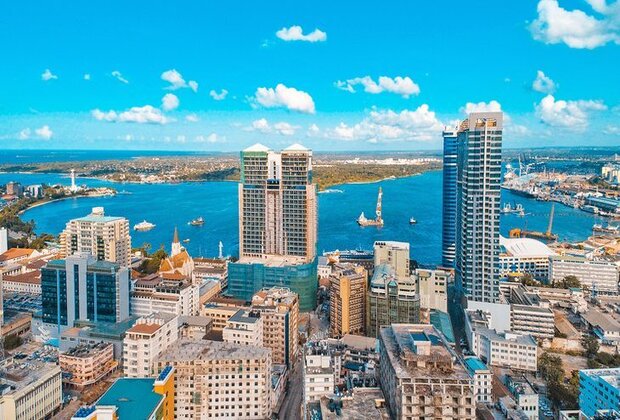
History of Dar es Salaam Tanzania
The city began to emerge in the middle of the 19th century when Sultan Majid bin Said of Zanzibar decided to build a new city close to Mzizima, a fishing village, and give it the name of Dar es Salaam. After the sultan’s death, the new Dar es Salaam began to decline. Still, the city restored its former splendor thanks to the arrival of the German East Africa Company, which was engaged in the construction of the Central Railway Line.
The British occupied this territory during WWI and the country was then named Tanganyika, before attaining its independence in 1961 and, together with Zanzibar, merged to form Tanzania; with Dar es Salaam as its capital.
Dar es Salaam, Tanzania, has recently experienced a construction boom, especially with the erection of the Twin Towers – the tallest building in the country.
The climate is wet and dry tropical, with an average temperature of 28°C throughout the year. Within an average year, there is a season of long rains and a season of short rains
Tips for travelers
Less than a three-hour drive from Dar es Salaam is the Mikumi National Park. Lions prowl this grassy kingdom for zebra, wildebeest, impala, and buffalo, while giraffes and elephants forage among the acacia. Safaris and guided walks are available for those who like to wander from the beaten path
The name means “haven of peace” in Arabic and was more fitting of Dar’s former status as a sleepy fishing village than this now booming metropolis. Straddling some of the most important sea routes in the world, Dar es Salaam harbor is Tanzania’s main port. On the northern section of the harbor is Kivukoni Front, with a bustling fish market where dhows sail in every morning at dawn to offload the night’s catch.
German colonists organized Dar by arranging a grid pattern of streets fanning out around the port. The Lutheran Church and St. Joseph Cathedral are notable structures on the waterfront, and the city has a worthwhile museum. The city’s architecture is a mix of Swahili, German, Asian, and British influences.
Activities and Best Things to Do in Dar es Salaam
Shop the Markets
To experience the sights and smells of an authentically Tanzanian market, it just has to be Kariakoo Market. Spread across several busy city blocks, it’s filled with everything from household goods to clothing and food. More touristy but with more crafts, Mwenge Carvers’ Market has an excellent blend of pieces made for tourists alongside genuine traditional items.
Tour the City Center
There’s no better way to get to know Dar than on one of the tours offered by Afri Roots. The tours, mostly conducted by bicycle, are a good mix of getting to know the city’s major historical landmarks and encounters with the locals. There’s even a tour dedicated to nightlife. It’s a terrific way to access Dar’s lively after-dark scene.
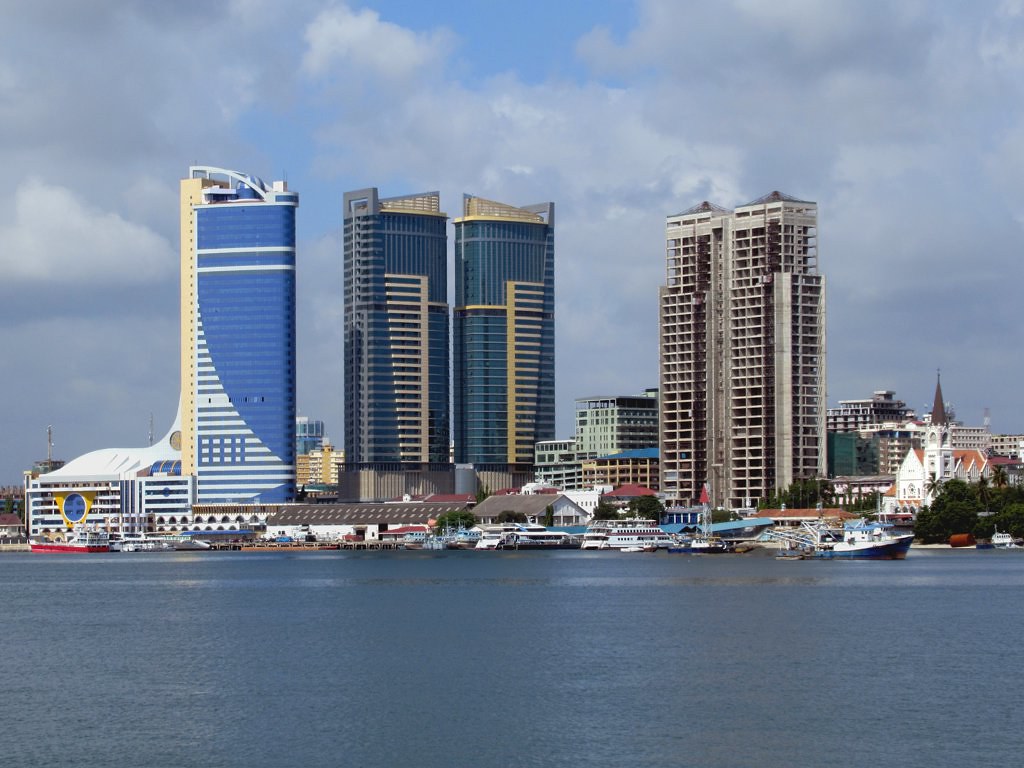
Get Out on the Water
The Indian Ocean off Dar is an underrated destination for diving, snorkeling, and just escaping the city to sail around beautiful local islands such as Bongoyo, Pangavini, and Mbudya. The Dar es Salaam Yacht Club runs sailing and fishing excursions, and, once back on shore, if you can take out a temporary membership you can use the club’s facilities, which include a swimming pool and a children’s playground.
National Museum of Dar Es Salaam
If you want to learn more about the history and culture of Tanzania or see some of the fossils that have been uncovered in the country, you’ll be interested in visiting the National Museum.
The museum is not set up most entertainingly, but if you are willing to read, you’ll learn quite a bit.
One of my favorite exhibits at the National Museum of Dar Es Salaam was a functional bicycle made entirely out of wood – everything from the frame to the wheels was all wooden – amazing
Tanzania’s capital in all but name, the city has some excellent museums, and they’re among the best things to do in Dar es Salaam. The biggest and best is the National Museum, which takes you on an intriguing journey through Tanzanian history. It begins with world-famous archaeological finds from Olduvai Gorge, then travels down through the slave trade and colonial era, and even houses former president Julius Nyerere’s Rolls-Royce. The Village Museum has reconstructed village scenes from all corners of the country, with live cultural performances and craftspeople at work to bring it all alive
Find the Best Street Food
You’ll eat well in Dar es Salaam, and what locals crave more than anything is a street barbecue. Every evening queues form at aromatic Barbecue House, close to Ali Hassan Mwinyi Road. Here locals order chicken, beef, or fish, served with naan bread and a choice of chilies, coconut chutney, or tamarind sauce. It’s a similar deal at Mamboz Corner, where Morogoro Road meets Libya Street, with Zanzibari marinades a highlight. Four times a year, the Nyama Choma Festival (Swahili for grilled meats) takes over Tunisia Road with barbecue cook-offs and live entertainment.
Bagamoyo Town
Similar to Mombasa or Lamu, Bagamoyo town located north of Dar Es Salaam, is an ancient East African trade port. The town has been influenced by Arabs and Indians to create a unique Swahili culture.
On a day trip to Bagamoyo, you can visit ancient ruins, old churches, and mosques and tour one of Tanzania’s only colleges of arts known as Chuo Cha Sanaa
Shop For Souvenirs
You can buy souvenirs at Kariakoo but you can also head to Slipway on the peninsula. It’s an open-air market where you can find gifts for family and friends. You can’t go home empty-handed!
As you can see, Dar es Salaam is worth considering when you visit Tanzania. Before heading to Zanzibar or Arusha, carve out some time in your schedule to explore one of Tanzania’s biggest and most populated cities
Azania Lutheran Church
Originally built by German missionaries in Tanzania, the Azania Lutheran Church is an iconic structure located on Dar Es Salaam’s harbor front. From the cathedral, you’ll have easy access to other tourist attractions around town.
When you enter the church, someone will probably approach you and start to guide you around, even without your asking. If you’re alright with this, just let me show you around, and at the end, they might ask for a donation to the church.
You can go up to the top of the Azania Lutheran Church, and see the bell tower.
Bongoyo Island
One of the most entertaining things to do in Dar Es Salaam is swim in the beautiful warm tropical Indian Ocean – but not right in Dar itself – there are a few locations that aren’t far that are much better (and cleaner).
Bongoyo Island is a small island off the coast of Dar that makes a fantastic day trip of lazying on the beach, snorkeling, and dining on fresh fried fish and chips.
Since becoming a marine reserve a few years ago, fees have severely increased, but it’s still worth it. Get to the island by taking a boat from The Slipway shopping center.
Tingatinga Art Center
Tanzanians have long been famous around Africa for their artwork (even on the streets of Dar). The modern movement of Tingatinga painting is one my my favorite styles of Tanzanian art.
An artistic movement that began with Edward Said Tingatinga, the style is characterized by extremely bright oil colors and cartoon imaginative figures.
The Tingatinga Center is a rainbow of color and artistic inspiration. You can browse around and buy anything you see
Admire the Art
Nafasi Art Space ranks among East Africa’s best galleries for contemporary art. You’ll see artists at work here in the studios that are hewn from a former industrial warehouse. There are exhibitions, workshops, and live performances most evenings.
Askari Monument
One of the most well-known historical statues of significance in Dar Es Salaam is the Askari Monument. Depicting a soldier with his bayonet pointing to the harbor, the monument is a reminder of the soldiers who fought in the Carrier Corps in World War I.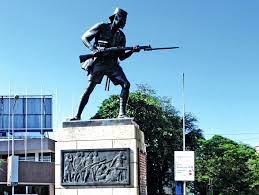
The cast bronze Askari Monument is supposedly located in the precise center of Dar, in the middle of the roundabout that bisects Samora Avenue with Maktaba Street.
South Beach – Kigamboni
Seclusion, peace, and quietness are how I would describe the South Beach area of Dar Es Salaam. There are several hotels that you can visit, or you can rent your banda thatch-covered hut for the day.
The lanky palm trees rustling in the breeze and the rhythmic wash of waves make spending a day at South Beach one of the most relaxing things to do in Dar Es Salaam.
Get there by personal vehicle or by local Dala Dala minivan. You’ll need to cross to the Kigamboni side of Dar by taking the ferry across the port – the ferry ride alone is an awesome Dar experience
Nyama Choma
Just like in neighboring Kenya, nyama Choma (roasted meat – often goat) is wildly popular – and incredibly delicious. Go to a local restaurant, order your choice of meat, and wait for it to slowly roast.
In Tanzania, nyama choma is served with a few chilies and sometimes a tomato and red onion garnish. Many Tanzanians choose to wash down their nyama choma with a few beers.
Dar es Salaam Botanical Gardens: Gardens with a Purpose
Established in 1893, the Dar es Salaam Botanical Gardens were initially used as a cash crop testing ground by the first agriculture director, Professor Stahlman. Today, they harbor the Horticultural Society, which takes care of several species of jacaranda, cycads, and palm. It also tends to some of the country’s most exotic plants, including the scarlet flame trees. Tour through the shady gardens that provide the dusty, hot city with a cool oasis suitable for plant life survival.
Dar es Salaam Botanical Gardens: Gardens with a Purpose
Established in 1893, the Dar es Salaam Botanical Gardens were initially used as a cash crop testing ground by the first agriculture director, Professor Stahlman. Today, they harbor the Horticultural Society, which takes care of several species of jacaranda, cycads, and palm. It also tends to some of the country’s most exotic plants, including the scarlet flame trees. Tour through the shady gardens that provide the dusty, hot city with a cool oasis suitable for plant life survival.
How to Get to Dar Es Salaam
Plane
The Julius Nyerere International Airport (DAR), Tanzania’s main airport, is located about 6 miles west of the city. A taxi ride to the city should cost about Tsh15,000.
Train
There are two train options through Dar es Salaam, including Tanzania Railways Limited, with connections to Dodoma and more. TAZARA Railway runs a scenic route through the Selous Game Reserve and onto Zambia.
Car
Highways connect Dar es Salaam to most major centers in the region and nationally, including the A-7 to Morogoro. The Tanzam Highway runs from Zambia to Dar es Salaam along the Cairo-Cape Town Highway.
Bus
Kilimanjaro Express and Dar Express are two of the largest bus companies with service to Dar es Salaam, offering connections to Arusha and beyond.
For more information kindly visit the link below
Welcome To Kigoma Town Tanzania
Kigoma is the main port, rail terminal, and largest town on the coast of Lake Tanganyika. It had a tumultuous history of involvement in slave and ivory trading in the yesteryear but declined once the western abolition campaigns started together with a falling population and silting up of the harbor, leaving it largely dependent on the Tanzanian mainland trade, although fishing and palm oil are still thriving sources of income.
In the past, Kigoma has competed with nearby Ujiji, but over the last decades Kigoma has gained a strong economic foothold in the region and its port is of central importance to the activities of the area.
The bustling town of Kigoma is the regional capital of western Tanzania and a central port in the area. Located on the eastern shores of Lake Tanganyika, Kigoma is surrounded by rugged mountains and forests that make it a pleasing and beautiful location.
Historically, the town was the final stop of the Central Line railway, built in the 20th century to transport agricultural goods from the African hinterland to the East African Coast. The town makes a good overland base for visits and chimpanzee safaris to both Gombe Stream National Park and Mahale Mountains National Park.
It is also one of the main access points for Western Tanzania’s National Parks, Gombe Stream, and Mahale Mountains, home to troops of wild chimpanzees; mankind’s fascinating nearest genetic kin. Road connections to the outside world are poor and ill-maintained although bus and rail links still variably function but cater towards the locals – not tourists. Proper maintenance records and liability transport insurance are non-existent and not best suited for international visitors.
Kigoma is also the central Administrative district of Tanzania’s western Province making it one of the busiest towns in the western part of Tanzania. Kigoma town is close to Ujiji town where Henry Morton Stanley explorer and Journalist met Dr. David Livingstone the missionary. Kigoma also doubles as an access route or gateway to the famous Gombe Stream National Park famous for chimpanzees trekking and other wildlife, the town also gets to you Mahale Mountains National Park another beautiful national park where chimpanzees can be trekked and viewed.
Kigoma is at the end of road B381, leaving the national road B8 at Kasulu. Roads are passable and steadily being improved. Traversing the country takes 3-4 days.
The ancient MV Liemba, built in 1913 by Germans, still plays up and down Lake Tanganyika between Kigoma and Mpulungu on the southern shores of the lake in Zambia, stopping at several cities along the coast. There are both first, second, and third classes onboard.
Attractions in Kigoma town.
Lake Tanganyika.
Lake Tanganyika is yet another attraction in Kigoma town, the world’s second deepest lake is shared by Tanzania, Burundi, Congo, and Zambia, but the largest part is in Tanzania and Kigoma offers the best points to experience the beautiful lake. The presence of Lake Tanganyika creates an amazing harbor leading to the development of scenic hotels on the shores as well as springing up beaches and activities such as boat cruises, and scuba diving among others.
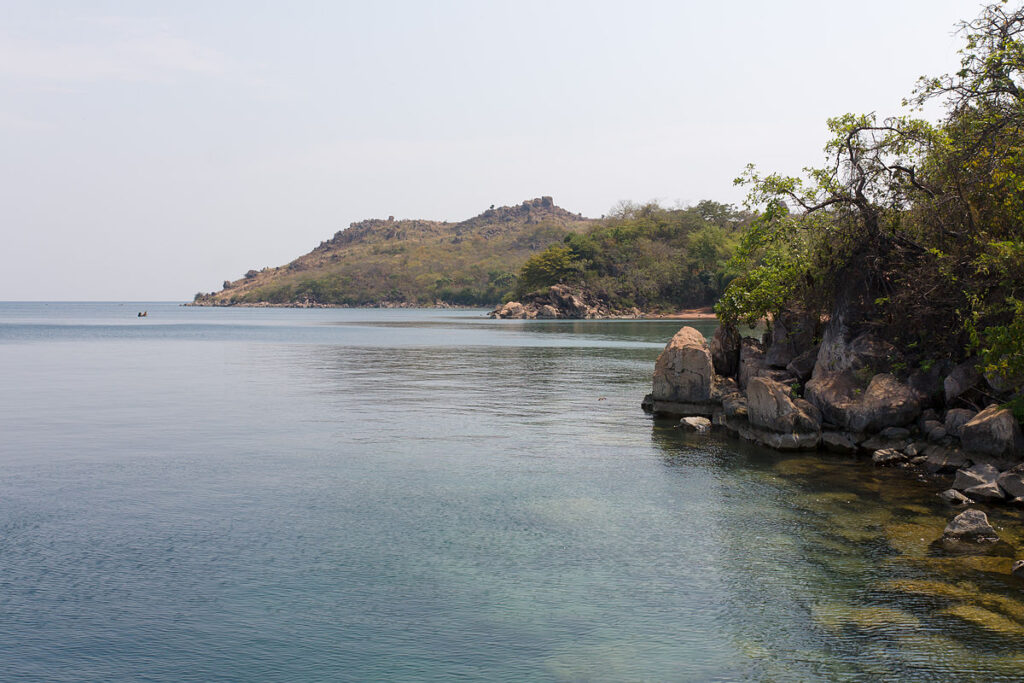
Beaches
Kigoma has beautiful beaches on the shores of Lake Tanganyika where several travelers and tourists go and relax to enjoy the clear waters as well as delve into it for a nice swim. The beaches offer several activities such as snookering, and boat cruises that take place at Lake Tanganyika. some of the known beaches in Kigoma include Jakobsen’s Beach, bangwe Beach among others.
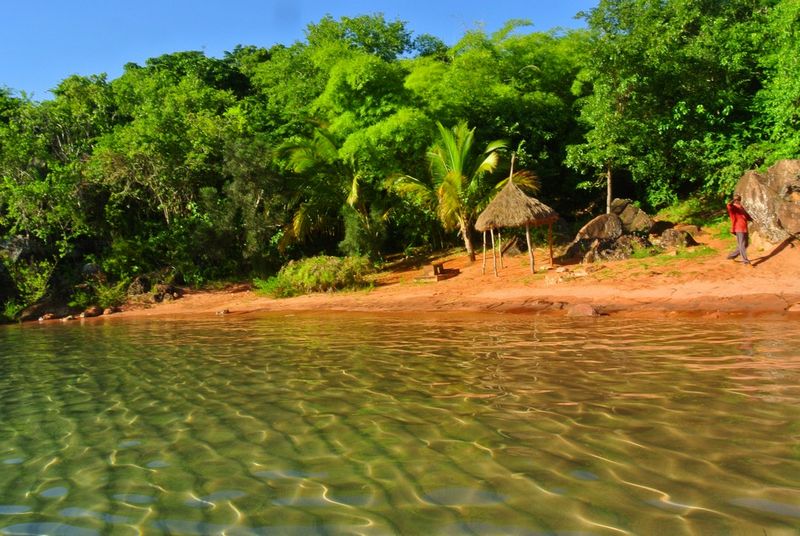
Gombe Stream National Park
Kigoma town offers a gateway to Gombe Stream National Park home to Tanzania’s chimpanzees, the park is accessible by taking a boat from Kigoma town. Gombe National Park besides primates offers a huge bio-network filled with lots of vegetation trees and plant species.
Mahale Mountain National Park.
This national park is traced to Lake Tanganyika it derives its name from the Mahale mountain ranges and is also the second protected area after Gombe National Park which is home to the chimpanzees also known as humans’ distant cousins. It is also known to have lions and chimpanzees existing in the same place.
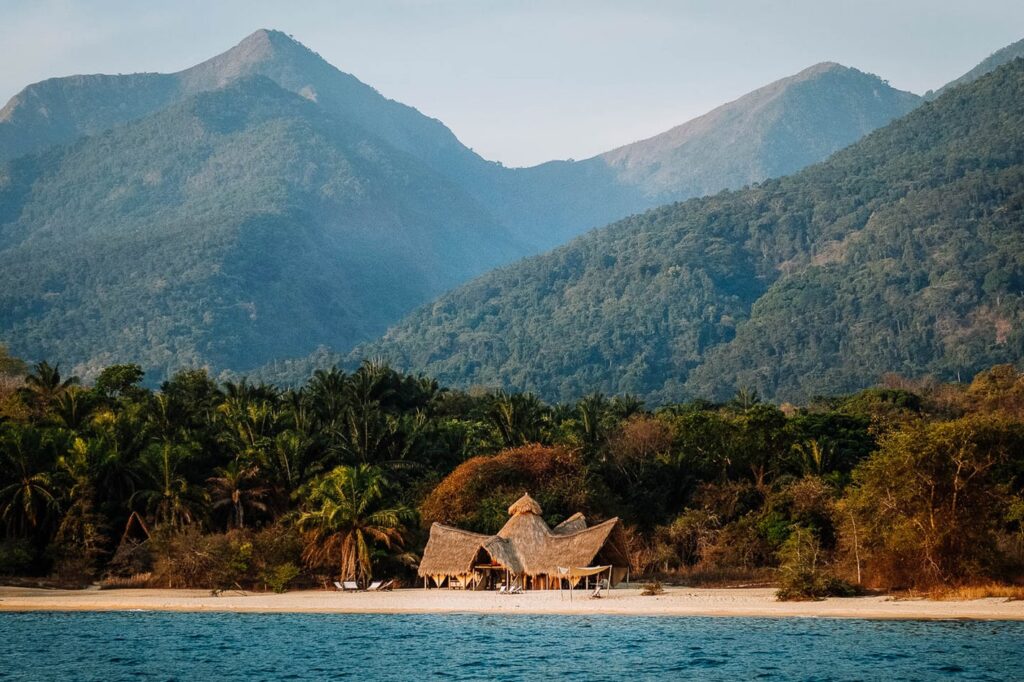
Accessing Kigoma town
Kigoma is pretty much accessible, from Arusha the tourism capital, one can charter a flight to Kigoma airstrip, depending on where you are coming from, one can also drive to Kigoma by road.
For more information kindly visit the link below
Welcome To Mwanza City
The city of Mwanza is the major Tanzanian port on Lake Victoria and a major center of economic activities in the region. The lake borders the country’s East African neighbors – Uganda to the northwest, and Kenya to the northeast.
Export and transport among the countries are the foundation of Mwanza’s economy. Around the city of Mwanza, the land is primarily devoted to agricultural enterprise. Tea, cotton, and coffee plantations throughout the area produce large volumes of cash crops that pass through Mwanza on their way to market. The town’s industrial harbor and busy streets make it a prosperous and busy place to explore.
For visitors, the city makes a good base from which to explore the nearby Rubondo Island National Park and the western parts of the Serengeti. Rubondo Island National Park offers pleasant day hikes and bird watching around the lake shore.
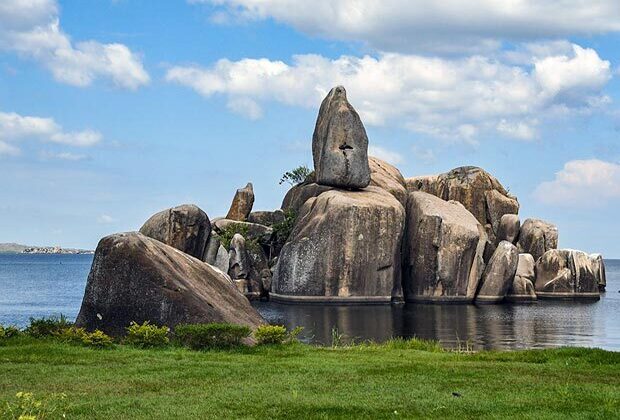
About Mwanza city
Mwanza’s proximity to the western Serengeti makes it a necessary stop for visitors who want to experience a less bust part of the park and see the magic of the Serengeti without the parade of safari vehicles and seasonal crowds. Mwanza is also the center of the Sukuma tribe, the largest tribe in Tanzania, who have inhabited and farmed the region for centuries. Cultural tourism programs to their local villages and farms can be arranged through the local cultural centers.
The Unit is located in Mwanza, the capital city of the Mwanza region, on the southern shores of Lake Victoria in North Western (NW) Tanzania. With a population of over 900,000, Mwanza is the second largest urban settlement in Tanzania after Dar es Salaam, and a major business center for regions around Lake Victoria and neighboring countries of Kenya, Uganda, Burundi, and Rwanda. The city is surrounded by rocky hills dotted with massive granite boulders.
The primary traditional economic activity in the Mwanza region is agriculture, with farmers growing a range of food crops and cotton for export markets. Other activities that have created new opportunities for socioeconomic development in the region include fishing and industrial fish processing for export markets and large-scale gold and diamond mining activities in neighboring regions. Mwanza is also experiencing major infrastructural development, with new highways opening to connect NW Tanzania to the city of Dar es Salaam and other parts of Tanzania, as well as other major cities in neighboring East African countries.
Arrival in Mwanza Town:
Air Transport in:
Mwanza City is served with air transport daily. About 35 to 40 aircraft shuttles at the single airport located in the Ilemela district. The aircraft frequenting the airport include passenger airlines such as ATCL, Air Express, and Precision Air, and hired shuttle planes to various destinations including Nairobi.
There are also Cargo aircraft landing at the airport weekly. The Cargo planes mainly come to carry fish fillets to Europe, the Middle East, and other world places.
Airport capacity:
The airports have a runway that can handle airplanes with weights of up to 180 tons. The airport has two main good runways. The first one with 3.3 km while the second has 3.0 km only. The big aircraft landing at the airport include the Boeing 737. The airport is busy and it is planned soon to be upgraded to the status of an International Airport.
Road network
The City comprising of Nyamagana and Ilemela districts has 35.5 km of trunk roads, 132 km of regional roads, and 695.5 km of district roads which makes a total of 861 km of the road network.
Existing tarmac roads radiating from the City are as follows:
- Mwanza – Kisesa (Musoma road ) – 17 km
- Mwanza – Nyashishi (Shinyanga road) – 19 km
- Mwanza – Airport (Airport road) – 10 km
Railway Transport
The City is at the railhead of the Mwanza – Dar es Salaam railway line receiving at least three passenger trains per week; leaving alone the continuous fleet of Cargo trains which are almost daily.
Marine Transport
The City is connected to Kenya and Uganda by Marine transport, which also connects it to the regional capitals of Bukoba and Musoma. It has two major ports; the South and the North ports owned by the Government parastatal organization known as the National Ports Authority. The North Port is the passenger terminal, while the South Port is the cargo terminal. It has ten ships/boats of which six are used to transport cargo and four are used for passengers and cargo
Mwanza City Tour: “The Pearl of Africa”
Mwanza City welcomes visitors with natural and fresh weather from the source of the River Nile off the shore of Lake Victoria. Mwanza City is an ideal place to start your adventure with wildlife safaris, boating and fishing on Lake Victoria or Rubondo Island, conducting research, or enjoying business. Mwanza City is a fast-growing city in Tanzania and is a dynamic, colorful destination of culture and life. It is a central point for Great Lakes countries in Africa, and the transit hub for many of Tanzania’s world-renowned tourist destinations like western and northern circuit wildlife safaris.
Mwanza City Activities
You can enjoy long bush walks and picturesque hikes, motorbike riding, boat cruises, lake fishing, and even visit famous kopjes or outcrops perched precariously on top of one another. Visit scenic islands, such as Ukerewe and Lukuba Islands, and expand your awareness by visiting cultural activities about Tanzania’s largest Bantu empire….”Basukuma.” Mwanza is a pleasant and exceptionally lively town with a lovely waterfront with excellent lake views. The rocky city is also endowed with unique fish called Sangara (Nile perch), “the mother fish of Basukuma,” in Lake Victoria (other fish such as Tilapia can also be found). Mwanza City has other unique tourist attractions, such as Igogo caves and underground tunnels (German Boma) that were used as an escape route when Germans ruled Basukuma.
Mwanza City Tour Summary
Begin the morning with a lovely breakfast at your hotel and depart at 8:00 a.m. for the Bujora Village to visit the Sukuma Museum, where you will learn about the traditions and culture of the largest tribe in Tanzania. The magic drums are fascinating at the museum, and you may even have the opportunity to play them in some exceptional cases.
After that, drive back to Mwanza City Center and begin a Lake Victoria adventure by boarding a speed boat. Sightseeing and bird watching are done en route to the Saa Nane Island, stopping at various rock outcrops where flocks of cormorants, egrets, ibises, and the occasional monitor lizard are known to sunbathe.
Sundowners enjoy the island’s impressive rocky vantage points with a spectacular view of Mwanza City as the sun sinks into Lake Victoria. Saa Nane National Park is small, but it’s like visiting a true paradise! End the day by returning to your hotel for the night.
Include
- Day trip according to the itinerary
- Transportation in a 4×4 safari vehicle
- Professional, English-speaking guide
- Meals according to the itinerary
- Mineral water
- All mentioned activities
- All national park fees
- Flying Doctor’s insurance (AMREF) during the day trip
Exclude
- Flights
- Optional Activities
- Alcoholic and soft drinks
- Visa fees
- Tips
- Personal spending money for souvenirs etc.
- Travel Insurance
HISTORY OF MWANZA CITY TOUR
The tour takes about 2-3 hours on foot. The historical tour mainly includes relics from the periods of the Germans, British, Indians, and early Tanzania.
The best starting point is the large roundabout or rotary near Lake Victoria (and near the Tourism Information Office, TIO) from where the three main roads lead: to the East (Nyerere Road), the South (Kenyatta Road), and the airport in the North (Makongoro Road).
Near the clock tower in the grass in the middle of the roundabout is an inscription recalling that in 1858, the British explorer John Speke was the first European to see from nearby Isamilo Hill the waters of Nyanza, which he called Lake Victoria after the reigning British Queen? He correctly claimed it to be the source of the river Nile.
On the wall of the clock tower is a British war Memorial. During the First World War, British troops coming from Kenya and Uganda drove out the German garrison of Mwanza, which fled to Tabora to the south. The British administered Tanganyika up to 1961.
There are several monuments from the German Period, which lasted only from the early 1890s to 1916. Across the street in the direction of the lake are former German offices with a small decorative wall in front. Here, criminals were condemned and hanged on the Gallows Tree, the trunk of which remains in the middle of the road to the East. On the hill to the east of Makongoro road, one can see a German Watch Tower, which was part of a large fortress that the Regional Commissioner now used as his official residence.
Welcome To Mwanza City
The city of Mwanza is the major Tanzanian port on Lake Victoria and a major center of economic activities in the region. The lake borders the country’s East African neighbors – Uganda to the northwest and Kenya to the northeast.
Exports and transport between the countries are the foundation of Mwanza’s economy. Around the city of Mwanza, the land is primarily devoted to agricultural enterprise. Tea, cotton, and coffee plantations throughout the area produce large volumes of cash crops that pass through Mwanza on their way to market. The town’s industrial harbor and busy streets make it a prosperous and busy place to explore.
Visitors can use the city as a base to explore the nearby Rubondo Island National Park and the western parts of the Serengeti. Rubondo Island National Park offers pleasant day hikes and bird watching around the lake shore.
About Mwanza city
Mwanza’s proximity to the western Serengeti makes it a necessary stop for visitors who want to experience a less bust part of the park and see the magic of the Serengeti without the parade of safari vehicles and seasonal crowds. Mwanza is also the center of the Sukuma tribe, the largest tribe in Tanzania, and has inhabited and farmed the region for centuries. Cultural tourism programs to their local villages and farms can be arranged through the local cultural centers.
The Unit is located in Mwanza, the capital city of the Mwanza region, on the southern shores of Lake Victoria in North Western (NW) Tanzania. With a population of over 900,000, Mwanza is the second largest urban settlement in Tanzania after Dar es Salaam, and a major business center for regions around Lake Victoria and neighboring countries of Kenya, Uganda, Burundi, and Rwanda. The city is surrounded by rocky hills dotted with massive granite boulders.
The primary traditional economic activity in the Mwanza region is agriculture, with farmers growing a range of food crops and cotton for export markets. Other activities that have created new opportunities for socioeconomic development in the region include fishing and industrial fish processing for export markets and large-scale gold and diamond mining activities in neighboring regions. Mwanza is also experiencing major infrastructural development, with new highways opening to connect NW Tanzania to the city of Dar es Salaam and other parts of Tanzania and other major cities in neighboring East African countries.
Arrival in Mwanza Town:
Air Transport in:
Mwanza City is served with air transport daily. About 35 to 40 aircraft shuttles at the single airport in the Ilemela district. The aircraft frequenting the airport include passenger airlines such as ATCL, Air Express, and Precision Air and hired shuttle planes to various destinations, including Nairobi.
Cargo aircraft also land at the airport weekly. These planes mainly carry fish fillets to Europe, the Middle East, and other places worldwide.
Airport capacity:
The airports have a runway that can handle airplanes weighing up to 180 tons. The airport has two main good runways. The first one with 3.3 km while the second has 3.0 km only. The big aircraft landing at the airport include the Boeing 737. The airport is busy and is planned to be upgraded to the status of an International Airport.
Road network
The City, comprising the Nyamagana and Ilemela districts, has 35.5 km of trunk roads, 132 km of regional roads, and 695.5 km of district roads, for a total of 861 km of road network.
Existing tarmac roads radiating from the City are as follows:
- Mwanza – Kisesa (Musoma road ) – 17 km
- Mwanza – Nyashishi (Shinyanga road) – 19 km
- Mwanza – Airport (Airport road) – 10 km
Railway Transport
The City is at the railhead of the Mwanza—Dar es Salaam railway line, receiving at least three passenger trains per week, not to mention the continuous fleet of Cargo trains, which are almost daily.
Marine Transport
The City is connected to Kenya and Uganda by Marine transport, which also connects it to the regional capitals of Bukoba and Musoma. It has two major ports, the South and the North, owned by the Government parastatal organization, the National Ports Authority. The North Port is the passenger terminal, while the South Port is the cargo terminal. It has ten ships/boats of which six are used to transport cargo and four are used for passengers and cargo.
Mwanza City Tour: “The Pearl of Africa”
Mwanza City welcomes visitors with natural and fresh weather from the source of the River Nile off the shore of Lake Victoria. Mwanza City is an ideal place to start your adventure with wildlife safaris, boating and fishing on Lake Victoria or Rubondo Island, conducting research, or enjoying business. Mwanza City is a fast-growing city in Tanzania and is a dynamic, colorful destination of culture and life. It is a central point for Great Lakes countries in Africa and the transit hub for many of Tanzania’s world-renowned tourist destinations like western and northern circuit wildlife safaris.
Mwanza City Activities
You can enjoy long bush walks and picturesque hikes, motorbike riding, boat cruises, lake fishing, and even visit famous kopjes or outcrops perched precariously on top of one another. Visit scenic islands, such as Ukerewe and Lukuba Islands, and expand your awareness by visiting cultural activities about Tanzania’s largest Bantu empire….”Basukuma.” Mwanza is a pleasant and exceptionally lively town and has a lovely waterfront that commands excellent views of the lake. The rocky city is also endowed with unique fish called Sangara (Nile perch), “the mother fish of Basukuma,” in Lake Victoria (other fish such as Tilapia can also be found). Mwanza City has other unique tourist attractions, such as Igogo caves and underground tunnels (German Boma) that were used as an escape route when Germans ruled Basukuma.
Mwanza City Tour Summary
Begin the morning with a lovely breakfast at your hotel and depart at 8:00 a.m. for the Bujora Village to visit the Sukuma Museum, where you will learn about the traditions and culture of the largest tribe in Tanzania. The magic drums are fascinating at the museum, and you may even have the opportunity to play them in some exceptional cases.
After that, drive back to Mwanza City Center and begin a Lake Victoria adventure by boarding a speed boat. Sightseeing and bird watching are done en route to the Saa Nane Island, stopping at various rock outcrops where flocks of cormorants, egrets, ibises, and the occasional monitor lizard are known to sunbathe.
Sundowners enjoy the island’s impressive rocky vantage points with a spectacular view of Mwanza City as the sun sinks into Lake Victoria. Saa Nane National Park is small, but it’s like visiting a true paradise! End the day by returning to your hotel for the night.
Include
- Day trip according to the itinerary
- Transportation in a 4×4 safari vehicle
- Professional, English-speaking guide
- Meals according to the itinerary
- Mineral water
- All mentioned activities
- All national park fees
- Flying Doctor’s insurance (AMREF) during the day trip
Exclude
- Flights
- Optional Activities
- Alcoholic and soft drinks
- Visa fees
- Tips
- Personal spending money for souvenirs, etc.
- Travel Insurance
HISTORY OF MWANZA CITY TOUR
The tour takes about 2-3 hours on foot. The historical tour mainly includes relics from the periods of the Germans, British, Indians, and early Tanzania.
The best starting point is the large roundabout or rotary near Lake Victoria (and near the Tourism Information Office, TIO) from where the three main roads lead: to the East (Nyerere Road), the South (Kenyatta Road), and the airport in the North (Makongoro Road).
Near the clock tower in the grass in the middle of the roundabout is an inscription recalling that in 1858, the British explorer John Speke was the first European to see from nearby Isamilo Hill the waters of Nyanza, which he called Lake Victoria after the reigning British Queen? He correctly claimed it to be the source of the river Nile.
On the wall of the clock tower is a British war Memorial. During the First World War, British troops coming from Kenya and Uganda drove out the German garrison of Mwanza, which fled to Tabora to the south. The British administered Tanganyika up to 1961.
There are several monuments from the German Period, which lasted only from the early 1890s to 1916. Across the street in the direction of the lake are former German offices with a small decorative wall in front. Here, criminals were condemned and hanged on the Gallows Tree, the trunk of which remains in the middle of the road to the East. On the hill to the east of Makongoro road, one can see a German Watch Tower, which was part of a large fortress that the Regional Commissioner now used as his official residence.
